
Simulation : a successful application
The hydraulic engineering center of Électricité de France (EDF) has for few years been setting up a software platform for modelling and advanced simulation. It covers every field (hydraulics, system control, electrotechnical, civil engineering, and mechanics) and uses the same methods. The modelling of hydraulic infrastructures is done in the Matlab/Simulink/Stateflow environment and relies on a “development repository”, an internal and methodological manual of which the purpose is to standardise programming practices and ease exchanges and knowledge capitalisation. An engineer builds his model drawing in a library of hydraulic and hydromechanic components (impoundments, galleries, weirs, valves, turbines…) and system control components (sensors, filters, controllers, dispatchers…). Then he completes it defining operating scenarios and adding tools to display results and analyse performance.
Several studies have been conducted since 2000. Thanks to advanced control applications developed with this simulation environment, the functioning of several structures in the EDF’s set of equipment has been fixed or optimised, and the maintenance cost has been lowered.
EDF implemented an automatic operator (supervision and control) for 6 hydraulic infrastructures located in Isère between Grenoble and Valence, working thanks to the hydraulic station in Lyon Valley. The innovative sides of this project are:
- modelling of the forebay’s dynamic behavior, identified thanks to water level records in the valley
- advanced control for a robust checking of water levels
- automatic generation of the program loaded in the calculator
On the Garonne River, three structures built in a row triggered high variations in the downstream water level. EDF made a model representing the whole site so as to reproduce its behavior with simulations. Afterward, they successfully implemented water level control.
This matter was also the subject of a joint publication at “Advanced techniques and innovative strategies for industrial processes modelling and robust control law” congress.
Siwha bay in Korea is closed by a dike. Simulation helped to set up a tidal power plant and its turbine control law to ensure maximum electricity production according to construction cost and environmental constraints.
In Cère Valley, the hydroelectric plant of Lamativie collects water from an impoundment at Montvert located 11 km upstream thanks to a gallery. Using simulations, EDF reduced the gallery’s input valve solicitation by controlling the water level in the impoundment, and optimised flow distribution on 3 turbines so as to lower the number of starting and ending cycles.
